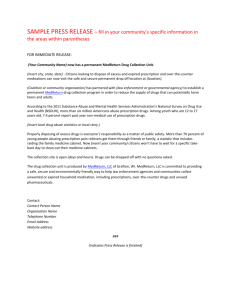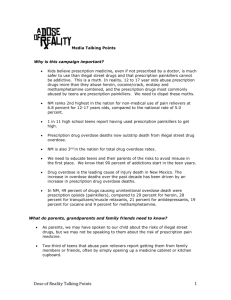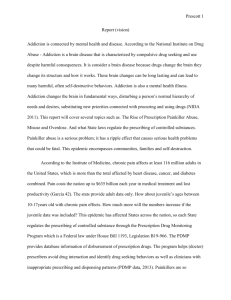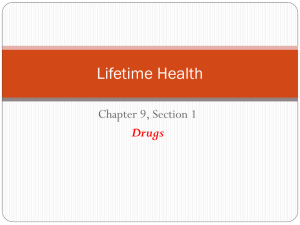Questions and Answers - Prescription Painkiller Overdoses Q: What
advertisement
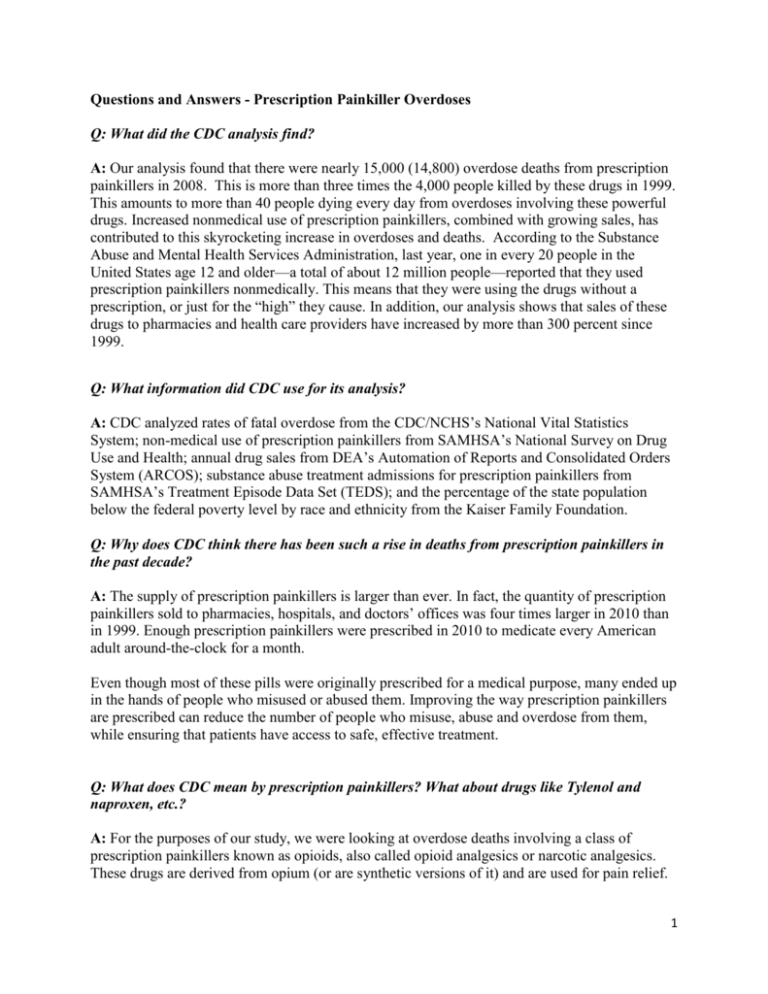
Questions and Answers - Prescription Painkiller Overdoses Q: What did the CDC analysis find? A: Our analysis found that there were nearly 15,000 (14,800) overdose deaths from prescription painkillers in 2008. This is more than three times the 4,000 people killed by these drugs in 1999. This amounts to more than 40 people dying every day from overdoses involving these powerful drugs. Increased nonmedical use of prescription painkillers, combined with growing sales, has contributed to this skyrocketing increase in overdoses and deaths. According to the Substance Abuse and Mental Health Services Administration, last year, one in every 20 people in the United States age 12 and older—a total of about 12 million people—reported that they used prescription painkillers nonmedically. This means that they were using the drugs without a prescription, or just for the “high” they cause. In addition, our analysis shows that sales of these drugs to pharmacies and health care providers have increased by more than 300 percent since 1999. Q: What information did CDC use for its analysis? A: CDC analyzed rates of fatal overdose from the CDC/NCHS’s National Vital Statistics System; non-medical use of prescription painkillers from SAMHSA’s National Survey on Drug Use and Health; annual drug sales from DEA’s Automation of Reports and Consolidated Orders System (ARCOS); substance abuse treatment admissions for prescription painkillers from SAMHSA’s Treatment Episode Data Set (TEDS); and the percentage of the state population below the federal poverty level by race and ethnicity from the Kaiser Family Foundation. Q: Why does CDC think there has been such a rise in deaths from prescription painkillers in the past decade? A: The supply of prescription painkillers is larger than ever. In fact, the quantity of prescription painkillers sold to pharmacies, hospitals, and doctors’ offices was four times larger in 2010 than in 1999. Enough prescription painkillers were prescribed in 2010 to medicate every American adult around-the-clock for a month. Even though most of these pills were originally prescribed for a medical purpose, many ended up in the hands of people who misused or abused them. Improving the way prescription painkillers are prescribed can reduce the number of people who misuse, abuse and overdose from them, while ensuring that patients have access to safe, effective treatment. Q: What does CDC mean by prescription painkillers? What about drugs like Tylenol and naproxen, etc.? A: For the purposes of our study, we were looking at overdose deaths involving a class of prescription painkillers known as opioids, also called opioid analgesics or narcotic analgesics. These drugs are derived from opium (or are synthetic versions of it) and are used for pain relief. 1 Examples include hydrocodone (Vicodin®), oxycodone (OxyContin®, Percocet®), fentanyl (Duragesic®, Fentora®), methadone, morphine and oxymorphone. In addition to the opioid prescription painkillers, there are other types of prescription painkillers available by prescription and over-the-counter such as the non-steroidal anti-inflammatory drugs naproxen and ibuprofen. However, in this study, we were specifically looking at opioid painkillers. Our sales data did not include buprenorphine, an opioid primarily used for substance abuse treatment, though sometimes prescribed for pain. Its inclusion with drugs primarily used to treat pain would have inappropriately increased sales rates. Q: Did CDC find geographic differences in death rates? What states or regions have the highest and lowest rates? Why? A: Yes. There was significant variation in drug overdose death rates among states; the highest in 2008 were in New Mexico and West Virginia, which had rates nearly five times that of the state with the lowest rate, Nebraska. Overall, the highest drug overdose death rates were in the Southwest and Appalachian region. We can’t say exactly why there is such variation among states, but we do know people in rural counties are about two times more likely to overdose on prescription painkillers than people in big cities. And our analysis shows that some of the states that saw the largest increases in overdose deaths between 1999 and 2008 were states that had some of the highest poverty levels among non-Hispanic whites. In addition, differences in prescribing habits among states may also account for some of the variation in overdose death rates. Regardless of the reasons that some states have higher death rates than others, drug overdoses in the United States are at an all time high, and all states can take steps to reduce this growing epidemic. Promising strategies include starting or improving prescription drug monitoring programs (PDMPs), which are electronic databases that track all prescriptions for painkillers and other abuseable drugs in the state, as well as holding healthcare providers accountable for responsible prescribing. Our Vital Signs fact sheet includes a variety of steps that CDC recommends states put into effect to reduce the problem of prescription drug overdose. Q: What does CDC think are safe prescribing practices for prescription painkillers? In what cases, and for how long, should they be prescribed? A: Organizations such as the American Pain Society/American Academy of Pain Medicine, the American College of Occupational and Environmental Medicine, and states like Washington and Utah have developed evidence-based guidelines for responsible prescribing of prescription painkillers. CDC believes that adopting and enforcing these types of evidence-based guidelines can be helpful in reducing prescription painkiller abuse. In general, these guidelines recommend: o Screening and monitoring for substance abuse and mental health problems. o Prescribing painkillers only when other treatments have not been effective for pain. 2 o Prescribing only the quantity of painkillers needed based on the expected length of pain. o Using patient-provider agreements combined with urine drug tests for people using prescription painkillers long term. o Talking with patients about safely using, storing and disposing of prescription painkillers.* o Using PDMPs to identify patients who are improperly using prescription painkillers. Q: Do most people who die from overdoses involving prescription painkillers have prescriptions for these drugs, or are they getting the drugs from others or using them illegally? A: Almost all prescription drugs involved in overdoses originally come from prescriptions. However, once they are prescribed, these drugs are often obtained by people who do not have a prescription. Data from SAMHSA’s National Survey on Drug Use and Health show that more than three out of four people who misuse prescription painkillers use drugs prescribed to someone else. The majority, about 55%, got these drugs, free of charge, from a friend or relative. A study examining overdose deaths, prescription drug monitoring program data and medical examiner files in West Virginia found that 63% of the people who died had contributory prescription drugs that could not be traced back to an actual prescription. Q: Are most people who die from a prescription drug overdose using these drugs alone or in combination with other drugs? A: About one half of prescription painkiller deaths involve at least one other identified drug, including benzodiazepines, cocaine, and heroin. Approximately 17% of prescription painkiller deaths between 1999 and 2006 also involved a benzodiazepine. Alcohol is also involved in many overdose deaths. Q: What are the estimated costs of prescription painkiller abuse in the United States? A: Several studies have estimated that prescription painkiller abuse costs between $54 and $72.5 billion each year. In addition, studies estimate that people who abuse prescription painkillers incur over eight times as much direct health care costs compared to people who do not abuse these drugs. It is clear that in addition to the significant loss of life and devastation of families and communities across the country, there is an equally devastating impact on healthcare costs. Q: Why are there so many more sales of these drugs in some states than in others? A: There is wide variability among states in terms of the sales of prescription painkillers to health care providers, hospitals, and pharmacies. Our analysis found that prescription painkiller sales per person were more than three times higher in Florida, the state with the largest volume of sales, than in Illinois, the state with the lowest volume of sales. We can’t say for certain why states vary so greatly in terms of sales. It is likely that prescribers who indiscriminately prescribe high volumes of prescription painkillers, i.e., pill mill physicians, account for some of the 3 differences among states. State variation in sales could also be the result of state policies and programs like prescription drug monitoring programs, pill mill and doctor shopping laws, and aggressive prescription claims review programs that identify and address providers inappropriately prescribing and patients misusing or abusing these drugs. However, it is critical that additional evaluations of these promising policies and programs are undertaken to further understand their impact on prescription painkiller sales and overdoses. Q: Who is most at risk of prescription painkiller overdose death? A: There are several groups of people who are at more likely to abuse or overdose on prescription painkillers. Many more men than women die of overdoses from prescription painkillers. Middle-aged adults have the highest prescription painkiller overdose rates. People in rural counties are nearly twice as likely to overdose on prescription painkillers as people in big cities. Whites and American Indian or Alaska Natives are more likely to overdose on prescription painkillers. About 1 in 10 American Indian or Alaska Natives aged 12 or older used prescription. painkillers for nonmedical reasons in the past year, compared to 1 in 20 whites and 1 in 30 blacks. People who obtain multiple controlled substance prescriptions from multiple providers— a practice known as “doctor shopping.” Those who use high-doses of opioids, and those who abuse multiple substances like opioids, sedatives, and alcohol. Medicaid populations have also been shown to be at greater risk of overdose compared to non-Medicaid populations. People who suffer with substance abuse and other mental health disorders Q: What does CDC recommend that states do to combat this problem? A: States, as regulators of health care practice and large public insurers, can take the following steps to help prevent overdoses from prescription painkillers and reduce this public health burden: Start or improve prescription drug monitoring programs (PDMPs), which are electronic databases that track all prescriptions for painkillers in the state. Use PDMP, Medicaid, and workers’ compensation data to identify improper prescribing of painkillers. Set up programs for Medicaid, workers’ compensation programs, and state-run health plans that identify and address improper patient use of painkillers. Pass, enforce and evaluate pill mill, doctor shopping and other laws to reduce prescription painkiller abuse. Encourage professional licensing boards to take action against inappropriate prescribing. Increase access to substance abuse treatment. 4 Q: What is CDC doing to help reduce the problem of prescription painkiller overdoses? A: CDC is committed to taking steps to reduce the prescription drug epidemic in the United States. In addition to sharing the findings of research and helping to share promising policies and programs with states, health care providers, health insurers, and the public, CDC is working with other federal agencies to: Track prescription drug overdose trends to better understand the epidemic. Educate health care providers and the public about prescription drug abuse and overdose. Develop, evaluate and promote programs and policies shown to prevent and treat prescription drug overdose and abuse, while making sure patients have access to safe, effective pain treatment. Q: What can doctors and other health care professionals do to help reduce this problem? A: To help combat the problem of prescription drug overdoses, CDC recommends that healthcare providers: Follow guidelines for responsible prescribing, including o Screening and monitoring for substance abuse and mental health problems. o Prescribing painkillers only when other treatments have not been effective for pain. o Prescribing only the quantity of painkillers needed based on the expected length of pain. o Using patient-provider agreements combined with urine drug tests for people using prescription painkillers long term. o Talking with patients about safely using, storing and disposing of prescription painkillers. Use PDMPs to identify patients who are improperly using prescription painkillers. Q What can individuals do to help address this issue? A: Individuals can take the followings steps: Use prescription painkillers only as directed by a health care provider. Make sure they are the only one to use their prescription painkillers. Not selling or sharing them with others helps prevent misuse and abuse. Store prescription painkillers in a secure place and dispose of them properly. Get help for substance abuse problems if needed (1-800-662-HELP). Q: Does CDC have tips for parents to help prevent children and youth from misusing prescription painkillers? A: Yes. Properly storing and disposing of prescription painkillers is an important step in preventing children and youth from accessing prescription painkillers. In addition, not sharing 5 medications with others and explaining to children and youth the dangers of prescription painkillers may also prevent children and youth from misusing these drugs. 6

